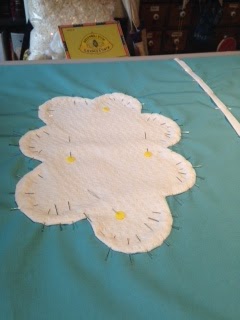
Like many quilters in this time of need, I've given over much of my studio time to making masks. Elastic has become like toilet tissue to find, so while waiting for a spool I ordered to arrive, I decided to try my hand at some of masks with strings. A friend in New Jersey pointed me towards this pattern,
A.B. mask for a nurse by a nurse. It makes a really good, well-fitting mask. I've made some changes to the construction, especially in the area of the binding/ties and since I've been asked about it by other sewists, I decided a tutorial was in order.
Step one is to go to the site above and print out the pattern.
(Q.L. amendments: Using polycarbonate, I cut out two little templates that make it easier to mark the two darts on the folds of the front and back of the mask. I also made a template to mark the side pleats.) Fabric should be 100% cotton. I have been using different fabrics for the masks and the ties and have dipped into my basket of conversation prints. You are cutting the mask pattern on the fold, so if your fabric is directional, keep that in mind. The top of the mask is the side with the long dart and it goes over the nose. The opposite side with the short dart goes over the chin.
With the front and the back of the mask still folded in

half, mark the long and short darts. Sew along the marked
lines. Since you will be clipping the darts, stitch back and
forth at the end of each dart to strengthen them. Clip each
of the darts nearly to the point
Press each of the darts open and then, with WRONG
sides together, pin the front to the back.
Sew around all the raw edges with a seam allowance less
than a quarter inch so that you can cover this stitching
when you attach the binding.

Next, mark the pleats. (I'm showing this with
another fabric because the little template
shows up better on the dark fabric.) Using the
longer dart as the top, make sure all the pleats
point toward the short dart.
Sew down the pleats on both sides stitching right on top of your previous stitching.
This is the end of the first part of the tutorial. Next, we will make the bias binding using the Quilters' Strip ticket to cover the edges and create the ties.




























































